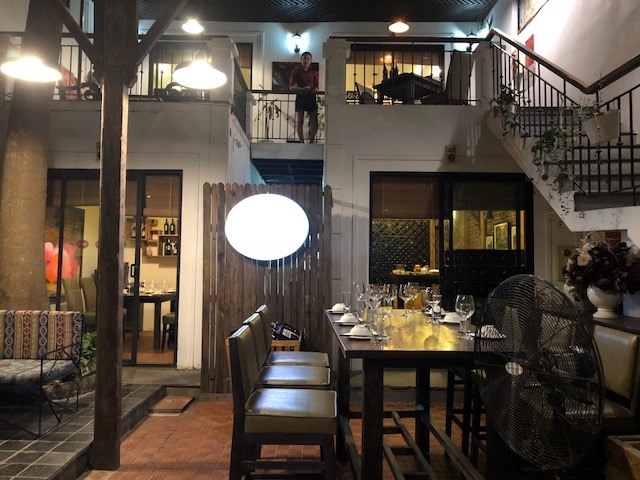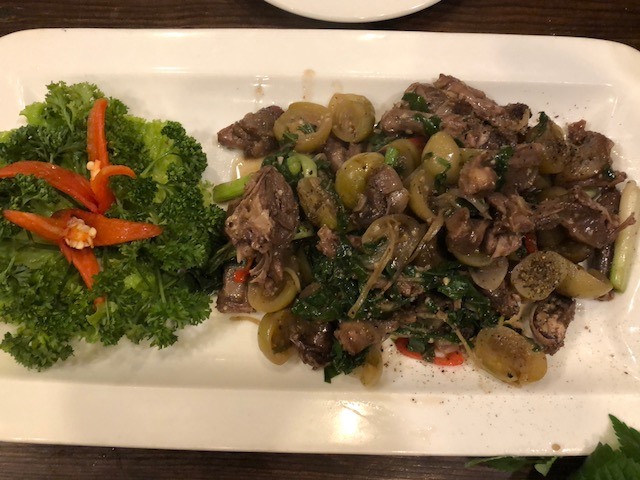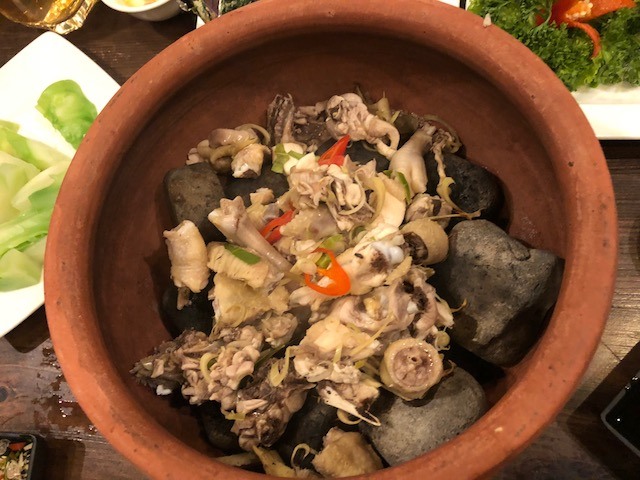 |
| The front view of 81.QT. — VNS Photo My Ha |
Viet Nam News
Rediscovering Vietnamese cuisine in a converted French villa proves to be a stimulating and tasty experience. Nguyen My Ha reports.
When you’ve lived in your hometown for a long time and nothing local can impress you any more, a surprise visit from a friend from afar may change your mindset.
It happened to me recently when we took our friend from the UK out for a Vietnamese dining experience.
We chose 81.QT, a Vietnamese restaurant located at the same number on Quan Thanh Street. It’s a French villa that’s been converted into a restaurant. We used to go there many years ago for mini-concerts held in the courtyard, but it has changed hands several times since then and now serves Vietnamese delicacies.
81.QT can sit about 100 diners, but the floor plan is divided into smaller rooms and spaces instead of one big dining hall like many new restaurants in urban centres.
The elegance of a French villa naturally gives diners a sense of privacy, even in the big hall downstairs. Diners can contemplate great photographs hanging on the walls and try the wine, bottles of which are lined up in racks around the house.
We wanted to try ngo xuan, a special vegetable in season at this time of year, but they had run out, so we settled for boiled vegetable dipped in hard-boiled eggs (VND109,000). The greens cut into big chunks served perfectly well as an appetizer.
Next we ordered cha oc (VND180,000), a new Ha Noi delicacy that had become a fixture in most new dining venues in town. Created by Ms Hang of Ha Noi’s famed bun oc shop on Phu Dong Thien Vuong Street, her baked escargot cakes are first dipped in chili sauce. Our friend had not tried this dish before, and said he liked it very much thanks to the tangy shallots that give the dish its main flavour.
“What did people in London think about the Trump-Kim summit in Ha Noi,” we asked our friend thinking we would like to know more about people’s opinions beyond the newspaper headlines and TV coverage about the summit that took Ha Noi by storm just last week.
“What about that summit? All we care about now is Brexit!” Prior to our conversation, the UK-EU talks had not produced any results after hours of negotiations. They were scheduled to continue the following day.
We were startled for half a second, realising that while what happened here made headlines around the world, most people care more about practical things that directly affect them.
Next we ordered a special pigeon dish: stir-fried chopped pigeon with Vietnamese seeded white pickled egg-plants (VND250,000). The waitress suggested the dish to us, which we were dubious about trying. She said it was a traditional Vietnamese dish and one of the restaurant’s signature plates.
 |
| The elegance of a French villa gives the restaurant a nice view from any angle. — VNS Photo My Ha |
 |
| Stir-fried pigeon with pickled egg-plant. — VNS Photo My Ha |
 |
| Surfing tofu, which means tofu gets tossed through the boiling oil as fast as a surfing boat. — VNS Photo My Ha |
 |
| Stone sauna bamboo chicken. — VNS Photo My Ha |
To be honest, I’ve tried many Vietnamese dishes from chim cau quay mat ong (roasted pigeons in five spices and honey), xoi chim, chopped pigeon in steamed sticky rice, and chim cau thuon hanh ram (pigeon in green onions and knee-weed leaves), but we had never heard of this dish. I tried it with hesitation because the pigeon meat was very tender and we usually tend to marinate it with warm flavours like salt or star-anise and honey. I doubted the sour taste of the egg-plant pickle would make the meat taste good.
To my surprise, only the pickle tasted sour, the pigeon meat tasted fine because it was accompanied by wild betel leaves which were fragrant and cured the coldness of the bird. Traditional Vietnamese medicine divides food into hot and cold categories: meat like beef, poultry and fish belong to the cold group and must be cooked with hot ingredients like ginger, garlic, tumeric and wild betel leaves to achieve a balanced taste.
If only the world was a more balanced place like the food cooked in the traditional Vietnamese way.
“Europe has become increasingly unsafe place, with far right groups emerging in many countries,” our friend said. “Anti-Semitism is growing and we have a feeling everything felt like in 1930s Europe.”
Next came the main course of chicken cooked on hot stones. Cooked in a clay-pot, we asked the chef to prepare it in the kitchen before he served it to our table. Normally this dish can be cooked on the table to add an exotic flavour. The chicken was from a special species called ga tre (VND395,000), which literally means bamboo chicken in English. Weighing less than a kilo each, what we had was more skin and bone than flavourful meat as we anticipated.
My favourite dish after the vegetables was the dau luot van (VND49,000) or surfing tofu, which is crispy on the outside and creamy, soft and buttery on the inside.
Unlike other meals when we would normally finish with a hot soup over rice, we decided to skip it and had the special green grapefruit for desert.
The food was delicious except for the chicken and we had a great time catching up. The atmosphere was cosy and sentimental, and was completed when our friend presented some books he’d bought for our kids: The Silk Roads, Alice in Wonderland and A Bear Called Paddington, in which he wrote: “This is my friend, and so are you!” — VNS
81.QT Vietnamese restaurant
81 Quan Thanh St.
Ba Dinh Dist.
Ha Noi
Tel. 024-3938-7777
Comment: Traditional Vietnamese food in French villa
OVietnam